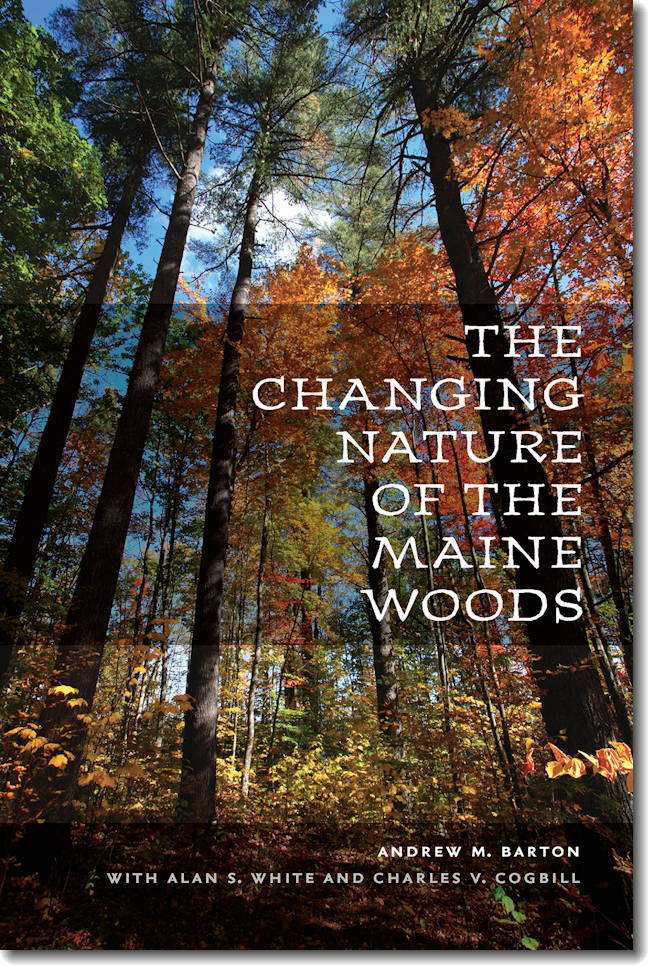“The Changing Nature of the Maine Woods” is the sixth book to highlight Maine’s forests that I have reviewed in these pages in as many years. Each investigated some aspect of the North Woods, as (full disclosure) did the chapter on Maine I wrote for a book about conservation in New England.
Each author brought his or her particular expertise to bear; at the same time, much would show up as a common intersection in a Venn diagram, if all the volumes were so described.
Andrew Barton and his co-authors are an exception only in attempting to pull every facet of their subject between two covers. Their book is chockablock with facts and figures of every conceivable dimension as they explain what Maine’s forests are and may become, based on where they have been, geologically, climatologically, topographically and in terms of settlement patterns and exploitation.
So comprehensive an approach carries with it an occupational hazard, which is how to straddle the gap between a work of reference and a book fit for a through-read by a more general public.
Do they manage it?
As I opened the book, the poem by Wes McNair that serves as its epigram gave me high hopes. As did the drama of a millennial clash on page 1: a quote from Thoreau (1846) cheek-by-jowl with the construction of the new Mercy Hospital (2007) and the remains of a 13,500-year-old spruce forest found lurking in its foundations.
Even as this forest flourished on the banks of the future Fore River, Barton continues, Moosehead Lake was only just emerging from the last glacier.
The distance — a mere 130 miles north — would prove to be equally significant when another great disruption took place much later, the arrival of the European.
With this fascinating set-up, Barton, a much-admired professor at UMaine Farmington, takes us back to Maine’s first post-Ice Age days, penetrating millennia season by season by boring into a peat bog. It is a good story, capturing both the science and the hard work of taking core samples, and he tells it well.
“On this day, scientific discovery is not a dry enterprise undertaken by the dispassionate, but an endeavor, full of surprise and inspiration, pursued by a wet, motley crew.”
From its emergence in the wake of the glaciers, we follow the forest as it bounces between boreal and more southern composition right down to the arrival of the English and French.
To the information embedded in the core samples, European settlement adds a two-fold boost to the authors’ researches: written accounts by the first explorers, and detailed silvicultural information from the earliest land surveys. Combining historical and ecological data, Barton pieces together a robust glimpse of pre-colonial forests.
Field research in the old-growth forest around Big Reed Pond provides another dimension. Cores taken from its trees found evidence, among other things, of regular outbreaks of spruce budworm back to the beginning of the 18th century.
So much has been written about the more recent history of the Maine Woods — by bureaucratic councils as well as scientists and latter-day Thoreaus — that finding something new to say or at least a new way of saying it is almost impossible. But I wish Barton and his fellow forest scientists had gone beyond the “some see others argue” posture, so common in environmental journalism, when addressing the results of various forms of forestry regulation, for instance. If they can’t hazard an opinion, who can?
Despite sporadic injections of first-person experiences to enliven it, “The Changing Nature of the Maine Woods” will owe its success to the astonishing amount of data it provides access to. Side-bars on many a fascinating topic abound, all thoroughly referenced. The bibliography alone is 40 pages long. The black and white photographs are unusually clear. A plethora of diagrams, graphs and tables illuminate the text. Lists of everything from explorers to species ensure that nothing is forgotten or omitted.
Having asked what seems like a rhetorical question — have the Maine Woods “reached a point of stability, or are processes at work now that will continue to alter forests?” — the authors give “a short answer: that the forces that shape forests — climate, insects and diseases, nonnative organisms, land use — are shifting in ways that are likely to considerably transform (them).”
It seems a pretty safe bet. And if that isn’t exactly news, Barton and his colleagues have taken advantage of the growing understanding of the complex relationship between history and ecology to shed a bit more light on “the diversity and changing nature of the Maine Woods.”
It is a useful addition to Maine’s natural resource literature.
Thomas Urquhart is a former director of Maine Audubon and wrote the chapter on Maine in “Twentieth-Century New England Land Conservation.”
Send questions/comments to the editors.



Success. Please wait for the page to reload. If the page does not reload within 5 seconds, please refresh the page.
Enter your email and password to access comments.
Hi, to comment on stories you must . This profile is in addition to your subscription and website login.
Already have a commenting profile? .
Invalid username/password.
Please check your email to confirm and complete your registration.
Only subscribers are eligible to post comments. Please subscribe or login first for digital access. Here’s why.
Use the form below to reset your password. When you've submitted your account email, we will send an email with a reset code.